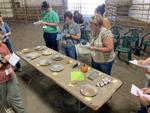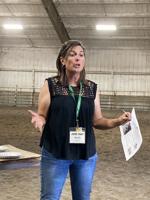While the common food source for cattle in Nebraska are the 23 million acres of rangelands, ruminants can also consume and convert many by-products, co-products and waste products that might otherwise end up in the landfill.
At the recent Herd That! Conference in Broken Bow, Nebraska, a Panhandle Research and Extension Center associate professor, discussed what types of by-products can supplement traditional pasture and feedlot diets.
Dr. Karla Wilke, who serves as a range management and cow-calf specialist, had participants identify 14 different items and asked, “Can these be used as cattle feed?”
Everything from cotton screenings to dried beet pulp to potatoes and cookies can and have been used in cattle diets across the state, the country and around the world, explained Wilke.

Workshop participants walk around a table hoping they can identify the 14 by-products, co-products and waste products displayed and also decide whether they are safe for cattle to eat. In the end all have been used a feed alternatives, with soybeans and field peas able to be used in moderation with a balanced ration.
“In the United States 40% of edible food is wasted every year with 34 million tons going into the landfill. This accounts for 20% of U.S. methane emissions. Feeding allowable food waste to livestock can reduce livestock production costs and greenhouse gas emissions,” she noted.
People are also reading…
Cattle are the ultimate upcyclers, said Wilke: “People cannot digest grass. Ruminants convert rangelands into protein, energy, vitamins and minerals that people can utilize.”
In the same way they can take waste products and convert them into high quality protein. Among those items are sugar beet pulp, a by-product of the sugar production industry; citrus pulp, a by-product of citrus juice production, and vegetables that start to spoil or are surplus.
A common co-product used in Nebraska are distiller’s grains, a co-product of the ethanol (biofuel) industry. Crop residues are also popular in the Cornhusker state, such as corn and soybean stover, even wheat or oat straw. These are often mixed in feedlot rations to provide needed roughage for the ruminants.
These and other feedstuffs can help further reduce methane emissions, something the cattle industry has been working to reduce through increased efficiency.
“In the last 50 years, beef production in the U.S. has increased by 25%, but cattle on feed has decreased by 6%,” Wilke said. “Fewer cattle producing more beef means less methane. Feeding corn in finishing diets reduces overall methane production. Overall, the carbon footprint of cattle production has decreased 18% since the 1970s.”

Dr. Karla Wilke from the University of Nebraska Panhandle Research and Extension Center leads a discussion about alternative feedstuffs for cattle during a session at the recent Herd That! Conference.
In addition, a recent study by the Environmental Protection Agency reported livestock and feed production combined represents only 3.9% of greenhouse gases in the U.S. with transportation, power production, and other industries contributing 80%.
So, when the post-Halloween pumpkins are shriveled into gruesome grimaces or stores and bakeries must dispose of broken or expired cookies, a possible alternative to sending them to a landfill or left to rot in a field is feeding them to cattle. An environmental win-win, Wilke said.
Barb Bierman Batie can be reached at editorial@midwestmessenger.com.
Cattle Eat That? - AgUpdate
Read More

No comments:
Post a Comment